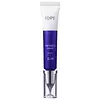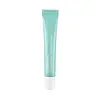What's inside
What's inside
 Key Ingredients
Key Ingredients

 Benefits
Benefits

 Concerns
Concerns

 Ingredients Side-by-side
Ingredients Side-by-side

Water
Skin ConditioningCaprylic/Capric Triglyceride
MaskingPropanediol
SolventGlycerin
HumectantDimethicone
EmollientTocopherol
AntioxidantTocopheryl Acetate
AntioxidantTrehalose
HumectantPanthenol
Skin ConditioningButyrospermum Parkii Butter
Skin ConditioningGlycine Soja Oil
EmollientAmmonium Acryloyldimethyltaurate/Vp Copolymer
Glyceryl Polymethacrylate
Helianthus Annuus Seed Oil
EmollientPolysilicone-11
Hydrogenated Lecithin
EmulsifyingHydroxyethyl Acrylate/Sodium Acryloyldimethyl Taurate Copolymer
Emulsion StabilisingPolyglyceryl-10 Stearate
Skin ConditioningOryza Sativa Bran Wax
Skin ConditioningCetearyl Alcohol
EmollientCarbomer
Emulsion StabilisingParfum
MaskingSodium Sulfite
PreservativeDaucus Carota Sativa Root Extract
Skin ConditioningTromethamine
BufferingRetinol
Skin ConditioningAllantoin
Skin ConditioningGlyceryl Caprylate
EmollientMannitol
HumectantGlyceryl Stearate
EmollientDisodium EDTA
Ethylhexylglycerin
Skin ConditioningStearic Acid
CleansingPolyglyceryl-3 Methylglucose Distearate
EmulsifyingPalmitic Acid
EmollientSorbitan Isostearate
EmulsifyingBHT
AntioxidantBeta-Carotene
Skin ConditioningMyristic Acid
CleansingLauric Acid
CleansingAcetyl Tetrapeptide-11
Skin ConditioningAscorbic Acid
AntioxidantLimnanthes Alba Seed Oil
Skin Conditioning3-O-Ethyl Ascorbic Acid
Skin ConditioningGlutathione
Sodium Hyaluronate
Humectant1,2-Hexanediol
Skin ConditioningHydrolyzed Hyaluronic Acid
HumectantSodium Hyaluronate Crosspolymer
HumectantHyaluronic Acid
HumectantSodium Acetylated Hyaluronate
HumectantWater, Caprylic/Capric Triglyceride, Propanediol, Glycerin, Dimethicone, Tocopherol, Tocopheryl Acetate, Trehalose, Panthenol, Butyrospermum Parkii Butter, Glycine Soja Oil, Ammonium Acryloyldimethyltaurate/Vp Copolymer, Glyceryl Polymethacrylate, Helianthus Annuus Seed Oil, Polysilicone-11, Hydrogenated Lecithin, Hydroxyethyl Acrylate/Sodium Acryloyldimethyl Taurate Copolymer, Polyglyceryl-10 Stearate, Oryza Sativa Bran Wax, Cetearyl Alcohol, Carbomer, Parfum, Sodium Sulfite, Daucus Carota Sativa Root Extract, Tromethamine, Retinol, Allantoin, Glyceryl Caprylate, Mannitol, Glyceryl Stearate, Disodium EDTA, Ethylhexylglycerin, Stearic Acid, Polyglyceryl-3 Methylglucose Distearate, Palmitic Acid, Sorbitan Isostearate, BHT, Beta-Carotene, Myristic Acid, Lauric Acid, Acetyl Tetrapeptide-11, Ascorbic Acid, Limnanthes Alba Seed Oil, 3-O-Ethyl Ascorbic Acid, Glutathione, Sodium Hyaluronate, 1,2-Hexanediol, Hydrolyzed Hyaluronic Acid, Sodium Hyaluronate Crosspolymer, Hyaluronic Acid, Sodium Acetylated Hyaluronate
Water
Skin ConditioningGlycerin
HumectantBrassica Campestris Sterols
EmollientCholesterol
EmollientPhytosteryl/Behenyl/Octyldodecyl Lauroyl Glutamate
Skin ConditioningMicrocrystalline Cellulose
Absorbent1,2-Hexanediol
Skin ConditioningPolyglyceryl-10 Oleate
Skin ConditioningSodium Hyaluronate
HumectantHydrogenated Lecithin
EmulsifyingPolyglutamic Acid
Skin ConditioningCeramide NP
Skin ConditioningRetinal
Skin ConditioningCapryloyl Salicylic Acid
ExfoliatingStearic Acid
CleansingOleic Acid
EmollientTocopherol
AntioxidantDisodium EDTA
Water, Glycerin, Brassica Campestris Sterols, Cholesterol, Phytosteryl/Behenyl/Octyldodecyl Lauroyl Glutamate, Microcrystalline Cellulose, 1,2-Hexanediol, Polyglyceryl-10 Oleate, Sodium Hyaluronate, Hydrogenated Lecithin, Polyglutamic Acid, Ceramide NP, Retinal, Capryloyl Salicylic Acid, Stearic Acid, Oleic Acid, Tocopherol, Disodium EDTA
 Reviews
Reviews

Ingredients Explained
These ingredients are found in both products.
Ingredients higher up in an ingredient list are typically present in a larger amount.
1,2-Hexanediol is a synthetic liquid and another multi-functional powerhouse.
It is a:
- Humectant, drawing moisture into the skin
- Emollient, helping to soften skin
- Solvent, dispersing and stabilizing formulas
- Preservative booster, enhancing the antimicrobial activity of other preservatives
Disodium EDTA plays a role in making products more stable by aiding other preservatives.
It is a chelating agent, meaning it neutralizes metal ions that may be found in a product.
Disodium EDTA is a salt of edetic acid and is found to be safe in cosmetic ingredients.
Learn more about Disodium EDTAGlycerin is already naturally found in your skin. It helps moisturize and protect your skin.
A study from 2016 found glycerin to be more effective as a humectant than AHAs and hyaluronic acid.
As a humectant, it helps the skin stay hydrated by pulling moisture to your skin. The low molecular weight of glycerin allows it to pull moisture into the deeper layers of your skin.
Hydrated skin improves your skin barrier; Your skin barrier helps protect against irritants and bacteria.
Glycerin has also been found to have antimicrobial and antiviral properties. Due to these properties, glycerin is often used in wound and burn treatments.
In cosmetics, glycerin is usually derived from plants such as soybean or palm. However, it can also be sourced from animals, such as tallow or animal fat.
This ingredient is organic, colorless, odorless, and non-toxic.
Glycerin is the name for this ingredient in American English. British English uses Glycerol/Glycerine.
Learn more about GlycerinHydrogenated Lecithin is created from the hydrogenation of lecithin (a group of phospholipids). Hydrogenation is a chemical reaction between hydrogen and another element.
This ingredient is an emollient and emulsifier. As an emollient, it helps soften skin by trapping moisture within. As an emulsifier, it prevents oil and water ingredients from separating.
Sodium Hyaluronate is hyaluronic acid's salt form. It is commonly derived from the sodium salt of hyaluronic acid.
Like hyaluronic acid, it is great at holding water and acts as a humectant. This makes it a great skin hydrating ingredient.
Sodium Hyaluronate is naturally occurring in our bodies and is mostly found in eye fluid and joints.
These are some other common types of Hyaluronic Acid:
Learn more about Sodium HyaluronateStearic Acid is a fatty acid. It is an emollient, emulsifier, and texture enhancer.
As an emollient, stearic acid helps soften skin. It aids the skin's protective barrier by preventing water loss. It also provides a gentle cleansing effect without stripping away natural oils.
Stearic acid may also be used to enhance the texture of products. It can add volume and stabilize ingredients such as water and oil. This can help water and oil ingredients from separating.
Sources of stearic acid include animal or vegetable fats/oils such as coconut or shea. It can be naturally found in butter, cocoa butter, shea butter, vegetable fats, and animal tallow.
This ingredient may not be Malassezia folliculitis, or fungal-acne safe.
Learn more about Stearic AcidTocopherol (also known as Vitamin E) is a common antioxidant used to help protect the skin from free-radicals and strengthen the skin barrier. It's also fat soluble - this means our skin is great at absorbing it.
Vitamin E also helps keep your natural skin lipids healthy. Your lipid skin barrier naturally consists of lipids, ceramides, and fatty acids. Vitamin E offers extra protection for your skin’s lipid barrier, keeping your skin healthy and nourished.
Another benefit is a bit of UV protection. Vitamin E helps reduce the damage caused by UVB rays. (It should not replace your sunscreen). Combining it with Vitamin C can decrease sunburned cells and hyperpigmentation after UV exposure.
You might have noticed Vitamin E + C often paired together. This is because it is great at stabilizing Vitamin C. Using the two together helps increase the effectiveness of both ingredients.
There are often claims that Vitamin E can reduce/prevent scarring, but these claims haven't been confirmed by scientific research.
Learn more about TocopherolWater. It's the most common cosmetic ingredient of all. You'll usually see it at the top of ingredient lists, meaning that it makes up the largest part of the product.
So why is it so popular? Water most often acts as a solvent - this means that it helps dissolve other ingredients into the formulation.
You'll also recognize water as that liquid we all need to stay alive. If you see this, drink a glass of water. Stay hydrated!
Learn more about Water